![]()
![]()
![]()
Use LEFT and RIGHT arrow keys to navigate between flashcards;
Use UP and DOWN arrow keys to flip the card;
H to show hint;
A reads text to speech;
62 Cards in this Set
- Front
- Back
|
Blood Specimens
Describe how it is treated after collection |
20mL rec adults
1:10 dilution in meadia to neutrolize bacteria properties and inactivate antibiotics 0.025-0.05% Sodium polyanethole-sulfante (SPS) - anticoagulant, inhibition of aminoglycocides |
|
|
Blood Specimens
What does lysis centerfugation do? |
increases the yeild of pathogens (TB, Brucella, Legionella)
|
|
|
Blood Specimens
What is special about leptospira cultures? |
pos only in first week of illness
1-3 drops of blood in each of several tubes with 5mL semi-solid (Fletcher or Ellinghausen) media. 30degree incubation in darkness for 28 days, dexamin specimen 1" under surface by darkfield weekly |
|
|
Tissue and Wound Specimens for Culture
Basics |
tissue or fluid better than swab for isolation
transport in screw top contatiners to lab ASAP |
|
|
Tissue and Wound Specimens for Culture
Do you use fixatives? |
No
EXCEPT Mtb, histoplasma, nocarida |
|
|
Tissue and Wound Specimens for Culture
How do you mince it? |
aseptically with sterile scissors and grind with steril mortar and pestle
|
|
|
Tissue and Wound Specimens for Culture
Why blender? |
Somacher lab blender increases the yeild of some athogens (pneummocytosis
|
|
|
Tissue and Wound Specimens for Culture
Abcesses: |
submit access wall and contents not just swab
|
|
|
Tissue and Wound Specimens for Culture
what kind of organismsm |
anaerobic
|
|
|
Stool and duodenal aspirate specimens for culture and microscopy
Vibrio Cholera - how to collect |
catheter collection
|
|
|
Stool and duodenal aspirate specimens for culture and microscopy
Vibrio Cholera - how to transport |
1 - alkaline peptone water
2 - cary-Blair - semi solid algar applicable to cholera and other enteropathogens 3 - Venkatraman-Ramkrishnan Medium - buffered sea salt medium used in Inda, survival 6 wk-6mth 4 - Monsur's Transport - 5 - blotting paper strip |
|
|
Stool and duodenal aspirate specimens for culture and microscopy
Non -Vibrio Cholera - transport |
1 - cary-blair (with or without Skirrow antibiotics)
2 - Enteric-Plus |
|
|
Vibrio Pathogens transported
|
frozen stool, unpreserved
|
|
|
Parasites
|
1 - 5-10% formalin or Merthiolate Iodine Formalin (MIF), for rapid field examination concentration only by centrifugation
2 - Polyvinyl Alcohol (PVA) for permanent smears, preserves trophozoites - cannot concentrate |
|
|
Duodenal/Gastric Contents - testin for giardia lamblia, strongy stercoralis, salmoella typhi
|
1 - entertest capsule - duodenal intubation - twice as sensitive as stool exam for giardia, important to verify pH
2 - gastric contents for M.tb |
|
|
Cerebral spinal fluids
|
1 - culture - centrifugaion 1500g * 15 min for seman and culture
2. Staining - gs or acridine orange, india ink (cryptocococcal) 3 - latex agglutination - H flu, N. miningities, S. pneumo, GBS 4 - Anigen test - Cryptococcus 5 - Wet Prep: Giemsa for Naegleria, exam for motility 6 - Serologic - measles |
|
|
Respiratory Secreions
|
1 - nasopharyngeal swabs detect carriage
2 - throat cultures: Spyogenes, C.dyptheriae, N.gonorrhea 3. Herpetic stomatitis - avoid calcium alginate 4 - Sputum cultures for bacteria unreliable GS with >25 squamous epi per 100x field -= contaminated spec 6 - TB - ealry am fresh sputum induced by aerosol |
|
|
Urinalysis
|
1 - spun sediment: 5mL od urin with >20WBC/hpf assoc iwth >10o,ooo orgs per mL
2 - proteinuria, pyuria, casts, hematuia, low specific grav 3 - staining 1 org/ 100x field assoc with sig UTI 4 can have sig bacteruia with normal ua 5 - pyruria with neg cult, think renal tb |
|
|
urine cult
|
1 - clean cathc midstream > 4yo
2 - cahterizaion Suprapubic bag specimen |
|
|
urine diagnositc criteria
|
clean catch >100,000 per mL with symptoms
catherizaion >1000 to 10000 orgs per mL with sympons suprapubic any growth bag - no growth or >1000000 of a single org Candiduia is always abnormal and not quantifialbe |
|

ID
|

Red cell cast in urine sediment
|
|

id
|

Sediment: Multiple red cells present (most have dysmorphic appearance), occasional red cell
|
|

ID
|

Granular cast in urine
|
|
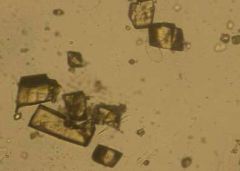
ID
|

Sulfonamide crystals are typically yellow in color and often resemble uric acid crystals. However, sulfa crystals are easily distinguished from uric acid by confirmatory tests. Sulfa crystals are readily soluble in acetone and exhibit a positive dextrine/sulfuric acid test ("old yellow newspaper
|
|

ID
|
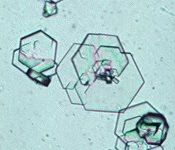
Cystine crystals are seen as flat colorless hexagonal plates. They often aggregate in layers, and their formation is favored in acidic urine.
Cystine crystalluria or urolithiasis is an indication of cystinuria, which is an inborn error of metabolism involving defective renal tubular reabsorption of certain amino acids including cystine |
|

id
|

Uric acid crystals may appear as yellow to brown rhombic or hexagonal plates, needles or rosettes. With rare exceptions, the finding of uric acid crystals in urine is of little clinical value
|
|

id
|

Triple phosphate (Struvite, Magnesium Ammonium Phosphate) crystals usually appear as colorless, prism-like "coffin lids". They are often seen in urine from clinically normal individuals. Although they can be found in urine of any pH, their formation is favored in neutral to alkaline urine
|
|

id
|

Transitional epithelial cells originate from the renal pelvis, ureters, bladder and/or urethra. Their size and shape depends on the depth of origin in the epithelial mucosa. Most often they are round or polygonal; less commonly pear-shaped, caudate or spindle-shaped. They are generally somewhat smaller and smoother in outline than squamous cells, but larger than WBC. They may develop refractile, fatty inclusions as they degenerate in older specimens (upper panel).
In cleanly-collected normal specimens, transitional cells are few Parabasal squamous epithelial cells are immature squamous epithelial cells. They are commonly seen in urine specimens from postmenopausal women with atrophic vaginitis resulting from decreased estrogen (estradiol) levels |
|

id
|
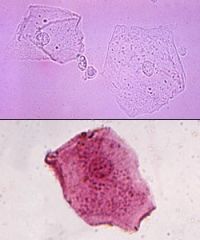
Squamous epithelial cells are the largest cells seen in normal urine specimens. They are thin, flat cells, usually with an angular or irregular outline and a small round nucleus. They may be present as single cells or as variably-sized clusters. Those shown in the upper panel are unstained; that in the lower panel was prepared using Sedi-Stain.
Squamous cells are common in lower numbers in voided specimens and generally represent contamination from the genital tract. Their main significance is as an indicator of such contamination |
|

id
|
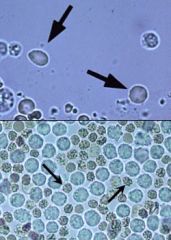
Fresh RBC tend to have a red or yellow color (lower panel). Prolonged exposure results in a pale or colorless appearance as hemoglobin may be lost from the cells (upper panel). In fresh specimens with a Specific Gravity (SG) of 1.010-1.020, RBC may retain the normal disc shape (upper panel). In more concentrated urines (SG>1.025), RBC tend to shrink and appear as small, crenated cells (lower panel). In more dilute specimens, they tend to swell. At a SG<1.008
White Blood Cells (WBC) in unstained urine sediments typically appear as round, granular cells which are 1.5-2.0 times the diameter of RBCs. WBC in urine are most commly neutrophils. Like erythrocytes, WBC may lyse in very dilute or highly alkaline urine; WBC cytoplasmic granules released into the urine often resemble cocci bacteria. WBC up to 5/HPF are commonly accepted as normal. Greater numbers (pyuria) generally indicate the presence of an inflammatory process somewhere along the course of the urinary tract (or urogenital tract in voided specimens). Pyuria often is caused by urinary tract infections, and often significant bacteria can be seen on sediment preps, indicating a need for bacterial culture. |
|

id
|
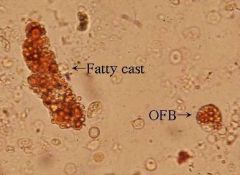
Oval Fat Bodies (OFB) are similar in composition and significance to fatty casts.
Desmorphic red cells (pictured ar right) are observed in glomerulonephritis. "Dysmorphic" red cells refer to heterogeneous sizes, hypochromia, distorted irregular outlines and frequently small blobs extruding from the cell membrane |
|

id
|
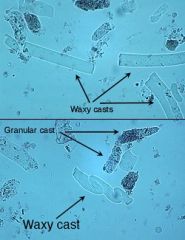
Waxy casts have a smooth consistency but are more refractile and therefore easier to see compared to hyaline casts. They commonly have squared off ends, as if brittle and easily broken.
Waxy casts are found especially in chronic renal diseases, and are associated with chronic renal failure; they occur in diabetic nephropathy, malignant hypertension and glomerulonephritis |
|

id
|

casts are identified by the presence of refractile lipid droplets. The background matrix of the cast may be hyaline or granular. Often, they are seen in urines in which free lipid droplets are present as well. Interpretation of the significance of fatty casts should be based on the character of the cast matrix, rather than on the lipid content. Pictured is a fatty cast with a hyaline matrix. As an isolated finding, lipiduria is seldom of clinical significance
|
|

id
|

Granular casts have a textured appearance which ranges from fine to coarse. Since they usually form as a stage in the degeneration of cellular casts, the interpretation is similar to that for cellular casts
|
|

id
|

Cellular casts most commonly result when disease processes such as ischemia, infarction or nephrotoxicity cause degeneration and necrosis of tubular epithelial cells. A common scenario is the patient with decreased renal perfusion and oliguria secondary to severe dehydration. Ischemic injury results in degeneration and sloughing of the epithelial cells. The resulting casts often are prominent in urine produced following rehydration with fluid therapy. The restoration of urine flow flushes numerous casts out of the tubules. Leukocytes can also be incorporated into casts in cases of tubulo-interstitial inflammation (eg., pyelonephritis).
|
|

id
|

Hyaline casts are formed in the absence of cells in the renal tubular lumen. They have a smooth texture and a refractive index very close to that of the surrounding fluid. When present in lower numbers (0-1/LPF) in concentrated urine of otherwise normal patients, hyaline casts are not always indicative of clinically significant disease. Greater numbers of hyaline casts may be seen associated with proteinuria of renal (eg., glomerular disease) or extra-renal (eg., overflow proteinuria as in myeloma) origin
|
|

id
|

A) Calcium oxalate crystals (arrows; 100 X); (B) uric acid crystals (100 X); (C) triple phosphate crystals with amorphous phosphates (400 X); (D) cystine crystals (100 X)
|
|

id
|

(A) Hyaline cast (200 X); (B) erythrocyte cast (100 X); (C) leukocyte cast (100 X); (D) granular cast (100 X
|
|

id
|

Squamous epithelial cells (arrows) and leukocytes (200 X).
|
|
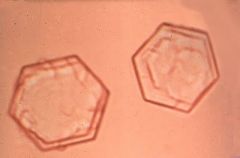
id
|

These cystine crystals are shaped like stop signs. Cystine crystals are quite rare
|
|

id
|

These "triple phosphate" crystals look like rectangles, or coffin lids if you are feeling depressed
|
|

id
|

These are oxalate crystals, which look like little envelopes (or tetrahedrons, depending upon your point of view). Oxalate crystals are common
|
|

|

This is a broad, waxy cast. Note that the edges are sharp and there are "cracks" in this cast
|
|

id
|

This is a broad, waxy cast. Note that the edges are sharp and there are "cracks" in this cast
|
|

id
|

Casts which persist may break down, so that the cells forming it are degenerated into granular debris, as has occurred in this granular cast
|
|

id
|

Red blood cell cast
Description: Microscopic urinalysis reveals a protein cast containing red blood cells. The RBC's are anucleate. The cast takes the shape of the renal tubule |
|

id
|

Legend: A: Hyaline cast; B: Fatty cast; C: Hyaline to finely granular cast; D: Cellular cast;
E: Cellular to coarsely granular cast; F: Coarsely granular cast; G: Finely granular cast; H: Granular to waxy cast, I: Waxy cast |
|

id
|

Legend: A: Hyaline cast; B: Fatty cast; C: Hyaline to finely granular cast; D: Cellular cast;
E: Cellular to coarsely granular cast; F: Coarsely granular cast; G: Finely granular cast; H: Granular to waxy cast, I: Waxy cast |
|

id
|

Waxy casts
|
|

id
|

White Blood Cells and Bacteria are Shown
|
|

id
|

(4+ bacteria and many white cells)
Probable urinary tract infection |
|
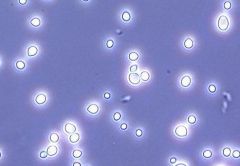
id
|

(4+ budding yeast)
Probable contaminants, No white cell seen |
|

id
|

White blood cells (WBC) in unstained urine sediments typically appear as round, granular cells which are1.5-2.0 times the diameter of RBC. The details of nuclear shape often are difficult to discern, especially if the specimen is not fresh. WBC in urine are most commonly neutrophils. Staining of air-dried sediment smears with a hematologic stain sometimes is useful for more specific identification. Like erythrocytes, WBC may lyse in very dilute or highly alkaline urine.
|
|

id
|

Classified as number per HPF: none seen, <5, 5-20, 20-100, or >100
Normal: Up to 5 RBC/HPF generally are considered acceptable for "normal" urine Round, slightly red-tinged, smooth textured cells, which may be biconcave in fresh urine May be spiky (crenated) in stored urine May lyse in very alkaline or dilute (USG < 1.008) urine |
|

id
|
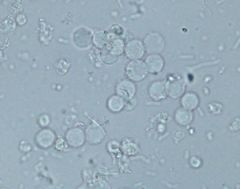
Classified as number per HPF: none seen, <5, 5-20, 20-100, or >100
Normal: Up to 5 WBC/HPF generally are considered acceptable for "normal" urine - these are normally segmented neutrophils Round, colorless cells with a grainy texture (see upper panel on left - bacterial rods are also visible in the background), may see nuclei of cells May lyse in very alkaline or dilute (USG < 1.008) urine Compared to RBC: WBC are more grainy and larger |
|

id
|

Compared to RBC: WBC are more grainy and larger
Compared to transitional epithelial cells: WBC are smaller with rounder borders than epithelial cells which vary in size, are less grainy and usually have eccentric nuclei (when visible) (see arrowed cell on lower panel on left which is from the same urine as the upper panel) |
|

id
|

Transitional epithelial cells
Variable size and shape (depends on origin): round or polygonal, pear-shaped, caudate (pelvis), tailed, spindle, may develop refractile, fatty inclusions with storage Compared to WBC: WBC are smaller and more uniformly round Compared to squamous epithelial cells: Transitional cells are smaller with rounder (not as angular) borders |
|
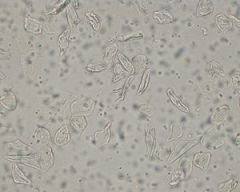
id
|

Largest cell in urine (image on the left was taken at lower magnification than the other images on this page)
Thin, flat cells, with angular border, anuclear or small central nuclues, present as single cells (shown on left) or in variably-sized clusters Represent contamination (from skin, genital tract, prepuce in male dogs) in voided urine or may reflect squamous metaplasia of prostate (from exogenous estrogen or an estrogen-secreting Sertoli cell tumor) especially if in large numbers |
|

id
|

Bacteria: Bacilli
Bacteria can be identified in unstained urine sediments when present in sufficient numbers by their characteristic rod shapes. This is more readily done for bacilli than cocci, which can mimic other structures. Bacteria are not seen in normal urine (which is sterile). Their presence could indicate an infection (particularly if in large numbers, of a uniform type or accompanied by pyuria) or contamination (more likely in voided samples) In the image on the left, bacteral rods (some in aggregates) are observed (arrows) in the background along with WBC (arrowhead) in urine from a cat with bacterial cystitis. |
|

id
|

Bacterial cocci are readily identified when they form long chains (likely Streptococcus species) as shown in the image of urine at left. However, doublets and clusters must be distinguished from small amorphous crystals, cellular debris, and small fat droplets, all of which show brownian motion in urine.
|
|

id
|
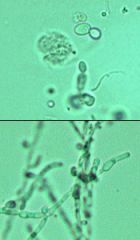
Yeasts in unstained urine sediments are round to oval in shape, colorless, and may have obvious budding (upper panel). They often represent contaminants, and are especially suspect if the sample is voided and/or old.
In other circumstances, however, their significance should not be discounted. The pictures shown here, for example, are of fresh urine collected by cystocentesis from a dog that had been on long-term antibiotic and immunosuppressive therapy. The lower photo shows pseudohyphae formation by the yeasts, which were identified on culture as Candida albicans. |
|

id
|

Fungal hyphae in urine sediment preps most commonly represent overgrowth of contaminants in samples where analysis was delayed.
If seen in a fresh sample, especially one collected by cystocentesis, fungal infection of the kidneys and/or bladder should be suspected. Aspergillus terreus (shown at left) has been documented to cause systemic infection including colonization of the renal pelvis. |

